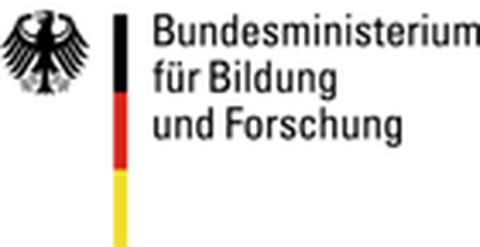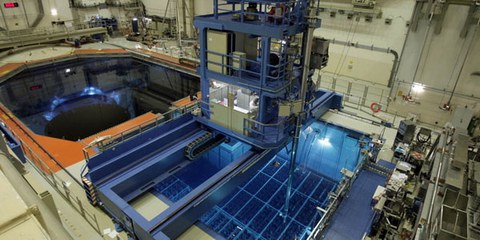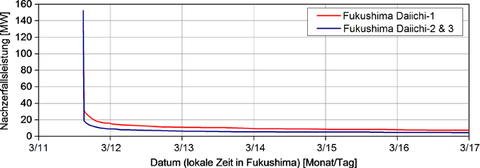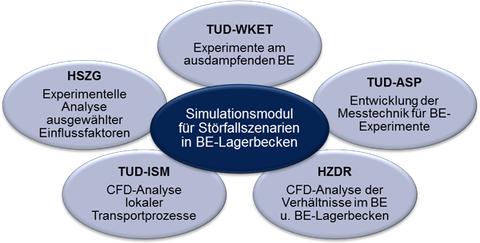SINABEL
Research project SINABEL "Safety of spent fuel pools: Experimental analysis,
modeling and validation of system and CFD codes„ within the framework of the BMBF funding concept "Basic Energy Research 2020+"
(Grant reference: 02NUK027)
Verbundprojektkoordination:
Technische Universität Dresden - Chair of Hydrogen and Nuclear Engineering (TUD WKET)
Sub-Projects:
- Technische Universität Dresden – Chair of Hydrogen and Nuclear Engineering (TUD WKET)
„Experimental and theoretical study of the decay heat removal from spent fuel in evaporating wet storage“
- Technische Universität Dresden – Institute of Fluid Mechanics (TUD-ISM)
„Simulation of flow and heat transfer in a fuel assembly under the conditions of a spent fuel pool“
- Helmholtz-Zentrum Dresden-Rossendorf - Institute for Fluid Dynamics (HZDR)
„Development of the model of a spent fuel pool based on a porous body approach“
- Hochschule Zittau-Görlitz – Institute of Process Engineering, Process Automation and Instrumentation (HSZG)
„Experimental investigation of density-driven vertical exchange movements of gases in rod bundle geometries“
- Technische Universität Dresden – AREVA Foundation Professorship for imaging measurement method for the Energy and Process Engineering (TUD-ASP)
„Spatially resolved temperature and gas phase velocity measurements for analyzing the flow conditions in evaporating fuel“
Term:
10/2013 - 09/2019
Funding:
BMBF
Description
An important aspect of nuclear safety is to ensure the decay heat removal from both the nuclear reactor and the spent fuel pool (SFP) (Fig. 1). The reactor accident that occurred on 11/03/2011 in Fukushima Daiichi has shown this in a special way. The operators - not only in Germany - are now requested to provide prove of the safety of SFP’s in currently operating and decommissioned nuclear facilities. The outage of pool cooling systems, followed by heatup, boiling and subsequent total evaporation is to be expected.
After the discharging of the reactor pressure vessel, the spent fuel is stored in the SFP for several years, while the released decay heat power decreases continuously. Typical values are 200 W per fuel rod after three days, down to 5 W after two years past discharge (Fig. 2).
Although the released heat of a single rod is relatively small, a total power of several megawatts must be dissipated from a fully loaded SFP. Normally, the water coverage of several meters height guarantees both the safe dissipation of heat and the radiological shielding. In the event of a loss of cooling of the SFP or a loss of water due to leakage, a scenario can develop which compromises the integrity of the fuel rods. If the water level drops below the top of the fuel rods, the cooling above is carried out by saturated or superheated steam. As soon as the water level reaches the lower end of the fuel rods, convective heat transfer is possible only by circulating room air. If the flow cross-sections are blocked, heat can only be dissipated by heat conduction and radiation. Based on the high overall decay heat in SFP’s, there is a great danger of overheating and destruction of the fuel elements with corresponding consequences. The thermal hydraulic phenomena of these incidents are currently neither qualitatively nor quantitatively sufficiently well investigated.
The main objective of the project is to predict the development of the axial and radial rod temperature profiles for different incident scenarios. Using a combination of experiments and simulations, proven knowledge of the heat transport processes shall be provided. Based on the experiments, existing codes (System and CFD) will be evaluated with regard to their applicability and models will be developed for the particular problem (Fig. 3).




